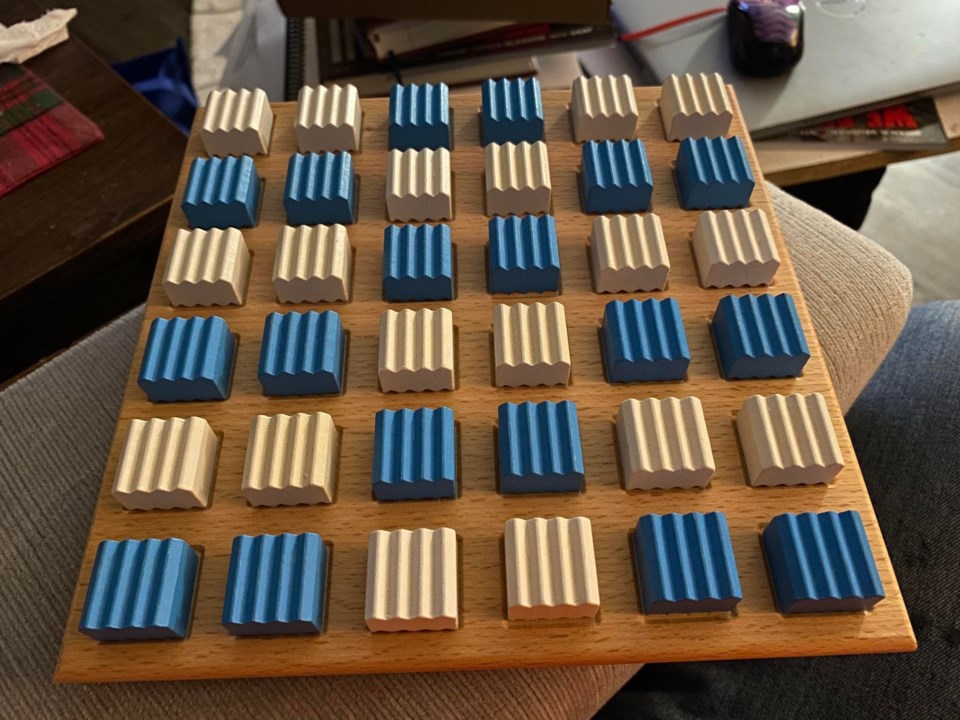YORKTON - When it comes to abstract strategy games, such as chess, go and all the others, personally I find those of wood generally draws my attention most quickly.
There is something simply aesthetically pleasing to my feels and in the tactile feel of wooden pieces.
In terms of wooden games publisher Clemens Gerhards makes games that are simply beautiful. They all have the look of something which should never be stored away in a box on a shelf, but rather be on display on a coffee or end table, or bookshelf. In my imaginary lottery-win mansion my study would have several as much for décor as play.
One such game is the 2021 design by Andreas Kuhnekath called Peak.
Peak is played on a 6X6 grid, which is something Gerhards makes outstanding.
The board starts with the board filled with pieces alternating colours in a set fashion.
When you move in Peak, you must always jump one of your single pieces over two playing pieces, which in this case are nicely stackable wooden pieces, although in this instance the decision to go with light blue and white in terms of colour was disappointing. I would have opted for black and white.
With the jumping mechanism, it reminds a bit of the classic Konane. However, in Konane you capture with jumps. In Peak the moved piece lands on another and stacks. The key is the jump must be over exactly two pieces, not more, not less. Unoccupied spaces are ignored; you can jump over them or use them as destination spaces. If the chosen destination space already contains a playing piece, you stack the new piece on top.
At the end of the game, the piece on top of a tower determines who scores for this tower; each playing piece in that stack is worth one point.
In a correspondence with the designer it was not surprising to learn he has been a long time game player.
“I've always been an avid gamer since childhood,” said Kuhnekath, but added “the question of a favorite game is difficult.
“It always depends a lot on who I play with and on what occasion.
“When it comes to which games I play most often, it's; The Quacks of Quedlinburg, Las Vegas and Roll for the Galaxy.”
Likewise, Kuhnekath said pinpointing where the idea for something comes from was not easy.
“It's often a very difficult question where an idea comes from, but in this case it's easy to answer, “he said. “In a math puzzle, there was a task to rearrange stacks of coins in a row.
The requirement was that you have to jump over two coins.
“I found this principle very interesting and immediately thought of making a game out of it.”
The core mechanic sort of set the goal for the game.
“Since the idea came from the mechanics, the actual goal was to develop a game for the movement mechanics,” said Kuhnekath.
“My goal with such abstract games is always to develop an elegant game with as few rules as possible.”
So what does Kuhnekath say players expect here?
“An exciting competition with a new movement rule and decisions to win the most towers,” he offered.
Kuhnekath added, “the development went pretty fast, because this time the basic mechanics were the origin and I ‘only’ had to find out on which board and with which game aim it makes a good game.
“From the first idea to sending it to the publisher it was only three months, the publisher then needed three months to check the idea -- which is also very fast.
“And, then another year until publication.”
So what was the most difficult aspect of designing the game?
“In this game everything has actually happily put together almost by itself,” said Kuhnekath. “It was more of a discovery than a development, as is often the case with such reduced abstract games.
“Of course, I still have to do some development work.
“The rule of movement was fixed and worked, the shape and size of the playing field was found quickly.
“The game's goal of building and controlling towers quickly became apparent.”
Of course there were experiments along the way.
“The starting line-up was a point where I tried slightly longer variations, among other things, I had tested an alternate use, which also worked well but does require some experience and was therefore out of the question for the publisher and we therefore we chose the setup in pairs,” said Kuhnekath.
So, in the designer’s mind what is the best element of the game?
“I like abstract games reduced to a minimum of rules and still offer a certain depth, but can still be played without too much brooding,” said Kuhnekath. “In my opinion, I managed this mixture well with Peak.”
In terms of something different from Peak Kuhnekath said the need to jump two pieces stands out for him.
“The movement mechanism is something new that has not existed before as I know (of), skipping two stones no matter how they are positioned.,” he said. “This simple element leads to surprising and exciting moves and fights on the board.”
Finally, I had to ask how it felt to hold a copy of the beautifully produced final product?
“I was lucky enough to publish six games and already two at Gerhard Spiele, (Rukuni the other in 2018),” said Kuhnekath. “Still, it's always great to hold the finished game in your hands, especially with the fantastic quality of how Gerhard produces his games.
“But it's even more exciting to see how people react to the games.
This is very possible via BGG (boardgamegeek.com), and I am always overwhelmed by people from all over the world playing my game and having a good time with it.”






